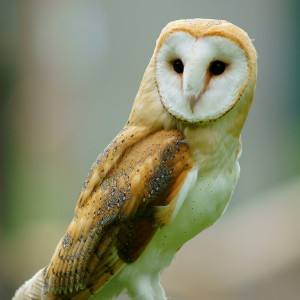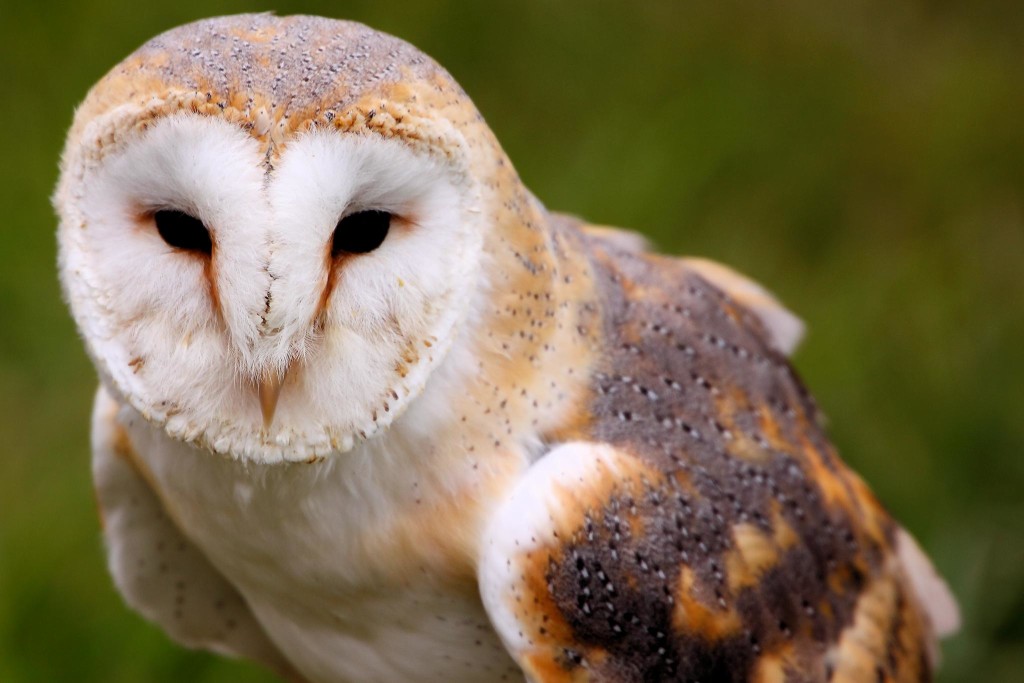 Owls are birds from the order Strigiformes, which consists of about 200 species of primarily nocturnal birds of prey that are adapted to be deadly night predators with silent flight, binocular vision, and asymmetric hearing.
Owls are birds from the order Strigiformes, which consists of about 200 species of primarily nocturnal birds of prey that are adapted to be deadly night predators with silent flight, binocular vision, and asymmetric hearing.
Owls are among a small group of flying animals that are active at night, yet do not use echolocation. To compensate, they have incredibly acute vision and hearing. Unlike most birds which have eyes on either side of their head, owls’ eyes are both positioned at the front of their heads, which increases depth perception. Their eyes are also well adapted to see at long ranges yet they have difficulty seeing up-close objects. Similar to other birds, owls’ eyes are fixed within their skull, due to a sclera in their eye – a bone that can contort the concavity of their eye to zoom their vision. However, in order to move their eyes, owls must move their entire head, and therefore are adapted to be able to rotate their heads a full 270°. In addition, the facial feathers of owls are adapted to collect sound and move it towards their ear holes. The ears themselves are asymmetrical and with ears set at different places on their skulls, owls are able to determine the direction from which the sound is coming by the minute difference in time that it takes for the sound waves to reach the left and right ears.
Most prey animals cannot see well at night, and it is therefore advantageous for owls to fly silently. They are able to achieve this with the help of specially adapted feathers that have a velvet-likeness that dampens sound and serrated edges that dampen the air disturbances caused by flapping.
Owl plumage is generally cryptic to hide them during the day, although several species have facial and head markings, including face masks, ear tufts and brightly coloured irises. These markings are generally more common in species inhabiting open habitats, and are thought to be used in signaling with other owls in low light conditions.
Owl Species of the Los Padres
Ten species of owls exist within the Los Padres National Forest, varying from the Northern Pygmy Owl, one of the smallest owls in the world, to the Great Horned Owl, the second heaviest owl in the Americas (after the Snowy Owl). Threats to our owl populations arise from habitat loss and disturbance – both in adequate roosting sites and adequate habitat to support prey populations. However, it is difficult to judge how owl populations have changed in response to these threats due to their secretive and nocturnal lifestyles.
The following owls are found within the Los Padres National Forest
Barn Owl
The barn owl is the most widely distributed species of owl in the world. It inhabits open habitats such as grasslands, agricultural fields, or oak savannah where it hunts for small mammals. In addition to their excellent low-light vision, barn owls have the best hearing of any animal that has been tested and can catch a mouse in a completely dark lab setting. Barn owls nest in holes in trees, cliff ledges, and crevices, and true to their name they also nest in barns and other human made structures. Barn owls are monogamous and mate for life. They are also territorial about their nesting site, but do not mind sharing hunting sites with other owls. The largest threats to barn owls are car strikes, and rodenticides – as rodents make up a significant portion of their diet. Thankfully, barn owls remain an IUCN species of least concern despite this. Click here to see a livecam of barn owls!
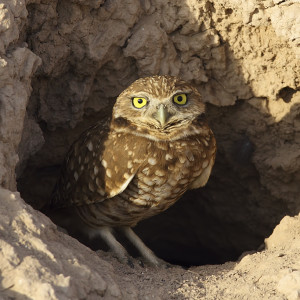 Burrowing Owl
Burrowing Owl
True to their name, burrowing owls live in burrows in the ground as opposed to holes in trees or rock faces. They may dig their own burrows, yet prefer to occupy existing ones created by other animals like prairie dogs. Similarly unique for the burrowing owl, is that they hunt during both the day and night and are most active at dawn and dusk. During the day the owls primarily hunt insects while at night the owls hunt for small mammals. These owls are most threatened by car strikes and their populations are generally decreasing throughout their ranges in the midwest.
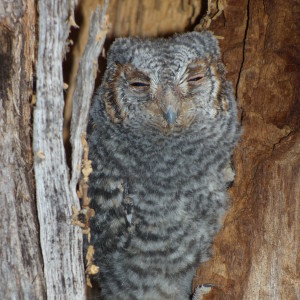 Flammulated Owl
Flammulated Owl
Flammulated owls are small owls that reside within mountainous pine forests. They make their nests in tree cavities, and prefer ponderosa pines. Unlike most other owls, flammulated owls hunt almost exclusively insects, especially, moths, crickets, and beetles. Flammulated owls are considered to be quite common, yet they are on the 2014 State of the Birds Watch List, which lists species most in danger of extinction without significant conservation action.
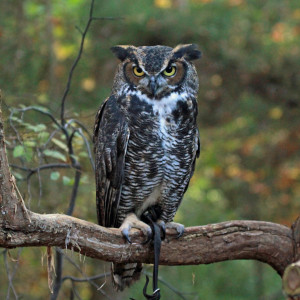 Great Horned Owl
Great Horned Owl
With its long, earlike tufts, intimidating yellow-eyed stare, and deep hooting voice, the Great Horned Owl is the quintessential owl of storybooks. This powerful predator can take down birds and mammals even larger than itself, but it also dines on daintier fare such as tiny scorpions, mice, and frogs. It’s one of the most common owls in North America, equally at home in deserts, wetlands, forests, grasslands, backyards, cities, and almost any other semi-open habitat between the Arctic and the tropics. The species adapts well to habitat change as long as nest sites are available. In the Pacific Northwest they have expanded into open land recently created by logging. Because of their prowess as predators, Great Horned Owls can pose a threat to other species of concern, such as Peregrine Falcons and Spotted Owls. Owls are sometimes poisoned by pesticides and other toxic substances that have accumulated in their prey.
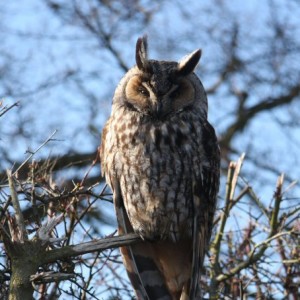 Long-Eared Owl
Long-Eared Owl
Long-eared Owls are lanky owls that often seem to wear a surprised expression thanks to long ear tufts that typically point straight up like exclamation marks. These nocturnal hunters roost in dense foliage, where their camouflage makes them hard to find, and forage over grasslands for small mammals. Long-eared Owls are nimble flyers, with hearing so acute they can snatch prey in complete darkness. In spring and summer, listen for their low, breathy hoots and strange barking calls in the night.
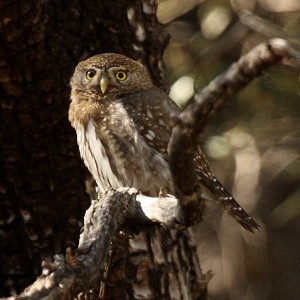 Northern Pygmy Owl
Northern Pygmy Owl
The Northern Pygmy-Owl may be tiny, but it’s a ferocious hunter with a taste for songbirds. These owls are mostly dark brown and white, with long tails, smoothly rounded heads, and piercing yellow eyes. They hunt during the day by sitting quietly and surprising their prey. As a defensive measure, songbirds often gather to mob sitting owls until they fly away. Mobbing songbirds can help you find these unobtrusive owls, as can listening for their call, a high-pitched series of toots.
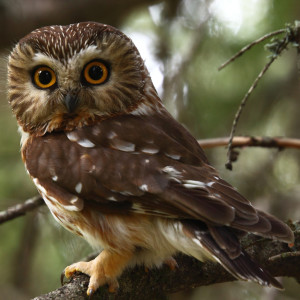
Photo by Kameron Perensovich
Northern Saw-whet Owl
A tiny owl with a catlike face, oversized head, and bright yellow eyes, the Northern Saw-whet Owl is practically bursting with attitude. Where mice and other small mammals are concerned this fierce, silent owl is anything but cute. One of the most common owls in forests across northern North America (and across the U.S. in winter), saw-whets are highly nocturnal and seldom seen. Their high-pitched too-too-too call is a common evening sound in evergreen mountain forests from January through May.
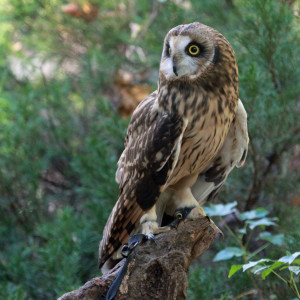 Short-eared Owl
Short-eared Owl
A bird of open grasslands, the Short-eared Owl is one of the most widely distributed owls in the world. It is found across North America, South America, and Eurasia, and on many oceanic islands. It inhabits open country, including prairie, meadows, tundra, moorlands, marshes, savanna, and open woodland; in the Hawaiian Islands also around towns; nesting on the ground.
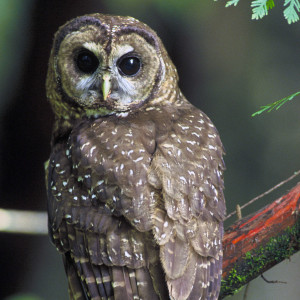 California Spotted Owl
California Spotted Owl
This species was recently petitioned to be listed as endangered under the Endangered Species Act. A denizen of mature coniferous forests, the Spotted Owl has been at the center of debates between forces for and against logging in the Pacific Northwest. Because of its role as the indicator species for old-growth forest, it has become one of the best-studied owls in the world. The California spotted owl is the lesser-known cousin of the Northern and Mexican spotted owl, and is found in the Los Padres National Forest and other parts of California. The California spotted owl is lighter brown in color and has larger white spots compared to its northern counterpart. Click here to learn more about the California Spotted Owl!
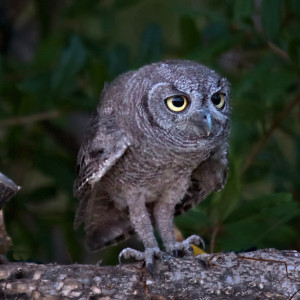 Western Screech Owl
Western Screech Owl
The western screech owl is a common small owl of the west. It prefers to associate with riparian and open woodland habitats where it can roost and nest in tree cavities. It preys on small mammals, insects, and even crayfish and has even been known to take animals larger than itself like cottontail rabbits or mallards.
Interested in learning more about owls? Head over to the Cornell Lab of Ornithology to see photos, hear their calls, and get a more detailed look at the life history of these owls, plus many more birds!

